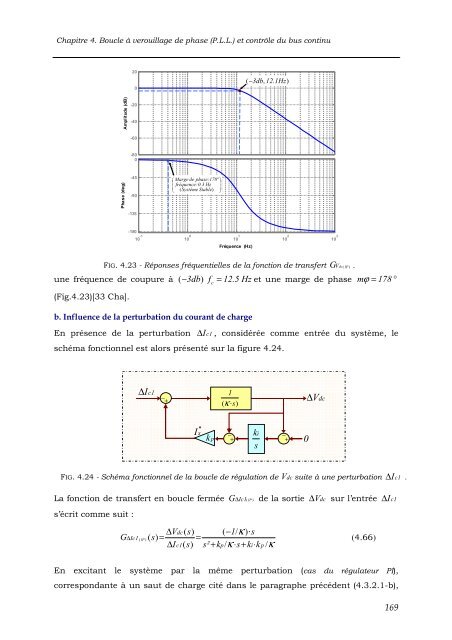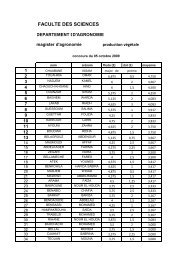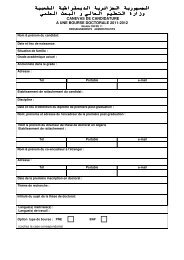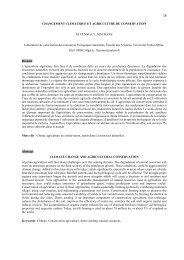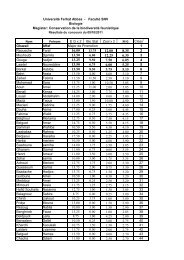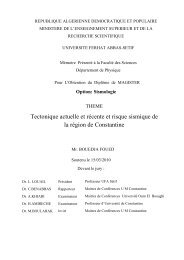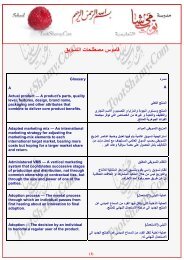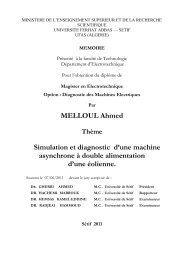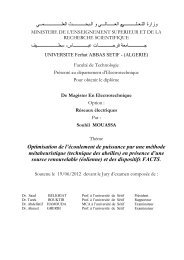- Page 1:
THÈSE Présentée dans le cadre d
- Page 4 and 5:
Ma reconnaissance et mes remercieme
- Page 7 and 8:
Table des matières Introduction G
- Page 9 and 10:
Table des matières 3.2.6 Le Driver
- Page 11 and 12:
Introduction Générale L'électron
- Page 13 and 14:
Introduction générale harmoniques
- Page 15 and 16:
Chapitre 1 ETAT DE L’ART : pollut
- Page 17 and 18:
Chapitre 1. Etat de l’art : pollu
- Page 19 and 20:
Chapitre 1. Etat de l’art : pollu
- Page 21 and 22:
Chapitre 1. Etat de l’art : pollu
- Page 23 and 24:
Chapitre 1. Etat de l’art : pollu
- Page 25 and 26:
Chapitre 1. Etat de l’art : pollu
- Page 27 and 28:
Chapitre 1. Etat de l’art : pollu
- Page 29 and 30:
Chapitre 1. Etat de l’art : pollu
- Page 31 and 32:
Chapitre 1. Etat de l’art : pollu
- Page 33 and 34:
Chapitre 1. Etat de l’art : pollu
- Page 35 and 36:
Chapitre 1. Etat de l’art : pollu
- Page 37 and 38:
Chapitre 1. Etat de l’art : pollu
- Page 39 and 40:
Chapitre 1. Etat de l’art : pollu
- Page 41 and 42:
Chapitre 1. Etat de l’art : pollu
- Page 43 and 44:
Chapitre 1. Etat de l’art : pollu
- Page 45 and 46:
Chapitre 1. Etat de l’art : pollu
- Page 47 and 48:
Chapitre 1. Etat de l’art : pollu
- Page 49 and 50:
Chapitre 2 FILTRE ACTIF PARALLELE :
- Page 51 and 52:
2.1 Caractéristiques de la charge
- Page 53 and 54:
2.1 Caractéristiques de la charge
- Page 55 and 56:
2.1 Caractéristiques de la charge
- Page 57 and 58:
2.2 Structure et caractéristique d
- Page 59 and 60:
2.2 Structure et caractéristique d
- Page 61 and 62:
2.2 Structure et caractéristique d
- Page 63 and 64:
2.2 Structure et caractéristique d
- Page 65 and 66:
2.2 Structure et caractéristique d
- Page 67 and 68:
2.2 Structure et caractéristique d
- Page 69 and 70:
2.3 Modélisation du SAPF au domain
- Page 71 and 72:
2.3 Modélisation du SAPF Du systè
- Page 73 and 74:
2.3 Modélisation du SAPF Avec : x
- Page 75 and 76:
2.3 Modélisation du SAPF seulement
- Page 77 and 78:
2.3 Modélisation du SAPF Ainsi, en
- Page 79 and 80:
2.3 Modélisation du SAPF Tableau 2
- Page 81 and 82:
2.3 Modélisation du SAPF La foncti
- Page 83 and 84:
2.4 Conclusion fixe ( α , β) et t
- Page 85 and 86:
Références [13 Gra] [14 Hol] [15
- Page 87 and 88:
Chapitre 3 ESTIMATION DES PARAMÈTR
- Page 89 and 90:
Introduction Plusieurs schémas et
- Page 91 and 92:
3.1 Estimation des paramètres du S
- Page 93 and 94:
3.1 Estimation des paramètres du S
- Page 95 and 96:
3.1 Estimation des paramètres du S
- Page 97 and 98:
3.1 Estimation des paramètres du S
- Page 99 and 100:
3.1 Estimation des paramètres du S
- Page 101 and 102:
3.1 Estimation des paramètres du S
- Page 103 and 104:
3.1 Estimation des paramètres du S
- Page 105 and 106:
3.1 Estimation des paramètres du S
- Page 107 and 108:
3.1 Estimation des paramètres du S
- Page 109 and 110:
3.1 Estimation des paramètres du S
- Page 111 and 112:
3.1 Estimation des paramètres du S
- Page 113 and 114:
3.1 Estimation des paramètres du S
- Page 115 and 116:
3.1 Estimation des paramètres du S
- Page 117 and 118:
3.1 Estimation des paramètres du S
- Page 119 and 120:
3.1 Estimation des paramètres du S
- Page 121 and 122:
3.1 Estimation des paramètres du S
- Page 123 and 124:
3.1 Estimation des paramètres du S
- Page 125 and 126:
3.1 Estimation des paramètres du S
- Page 127 and 128: 3.1 Estimation des paramètres du S
- Page 129 and 130: 3.2 Description du banc d’essais
- Page 131 and 132: 3.2 Description du banc d’essais
- Page 133 and 134: 3.2 Description du banc d’essais
- Page 135 and 136: 3.2 Description du banc d’essais
- Page 137 and 138: 3.2 Description du banc d’essais
- Page 139 and 140: 3.2 Description du banc d’essais
- Page 141 and 142: 3.2 Description du banc d’essais
- Page 143 and 144: 3.2 Description du banc d’essais
- Page 145 and 146: 3.2 Description du banc d’essais
- Page 147 and 148: Références [13 Ras] [14 Ron] [15
- Page 149 and 150: Chapitre 4 BOUCLES A VEROUILLAGE DE
- Page 151 and 152: Chapitre 4. Boucle à verouillage d
- Page 153 and 154: Chapitre 4. Boucle à verouillage d
- Page 155 and 156: Chapitre 4. Boucle à verouillage d
- Page 157 and 158: Chapitre 4. Boucle à verouillage d
- Page 159 and 160: Chapitre 4. Boucle à verouillage d
- Page 161 and 162: Chapitre 4. Boucle à verouillage d
- Page 163 and 164: Chapitre 4. Boucle à verouillage d
- Page 165 and 166: Chapitre 4. Boucle à verouillage d
- Page 167 and 168: Chapitre 4. Boucle à verouillage d
- Page 169 and 170: Chapitre 4. Boucle à verouillage d
- Page 171 and 172: Chapitre 4. Boucle à verouillage d
- Page 173 and 174: Chapitre 4. Boucle à verouillage d
- Page 175 and 176: Chapitre 4. Boucle à verouillage d
- Page 177: Chapitre 4. Boucle à verouillage d
- Page 181 and 182: Chapitre 4. Boucle à verouillage d
- Page 183 and 184: Chapitre 4. Boucle à verouillage d
- Page 185 and 186: Chapitre 4. Boucle à verouillage d
- Page 187 and 188: Chapitre 4. Boucle à verouillage d
- Page 189 and 190: Chapitre 5 STRATEGIES DE COMMANDE D
- Page 191 and 192: Chapitre 5.Stratégies de commande
- Page 193 and 194: Chapitre 5.Stratégies de commande
- Page 195 and 196: Chapitre 5.Stratégies de commande
- Page 197 and 198: Chapitre 5.Stratégies de commande
- Page 199 and 200: Chapitre 5.Stratégies de commande
- Page 201 and 202: Chapitre 5.Stratégies de commande
- Page 203 and 204: Chapitre 5.Stratégies de commande
- Page 205 and 206: Chapitre 5.Stratégies de commande
- Page 207 and 208: Chapitre 5.Stratégies de commande
- Page 209 and 210: Chapitre 5.Stratégies de commande
- Page 211 and 212: Chapitre 5.Stratégies de commande
- Page 213 and 214: Chapitre 5.Stratégies de commande
- Page 215 and 216: Chapitre 5.Stratégies de commande
- Page 217 and 218: Chapitre 5.Stratégies de commande
- Page 219 and 220: Chapitre 5.Stratégies de commande
- Page 221 and 222: Chapitre 5.Stratégies de commande
- Page 223 and 224: Chapitre 5.Stratégies de commande
- Page 225 and 226: Chapitre 5.Stratégies de commande
- Page 227 and 228: Chapitre 5.Stratégies de commande
- Page 229 and 230:
Chapitre 5.Stratégies de commande
- Page 231 and 232:
Chapitre 5.Stratégies de commande
- Page 233 and 234:
Chapitre 5.Stratégies de commande
- Page 235 and 236:
Chapitre 5.Stratégies de commande
- Page 237 and 238:
Chapitre 5.Stratégies de commande
- Page 239 and 240:
Chapitre 5.Stratégies de commande
- Page 241 and 242:
Chapitre 5.Stratégies de commande
- Page 243 and 244:
Chapitre 5.Stratégies de commande
- Page 245 and 246:
Chapitre 5.Stratégies de commande
- Page 247 and 248:
Chapitre 5.Stratégies de commande
- Page 249 and 250:
Chapitre 5.Stratégies de commande
- Page 251 and 252:
Chapitre 5.Stratégies de commande
- Page 253 and 254:
Chapitre 5.Stratégies de commande
- Page 255 and 256:
Chapitre 5.Stratégies de commande
- Page 257 and 258:
Chapitre 5.Stratégies de commande
- Page 259 and 260:
Chapitre 5.Stratégies de commande
- Page 261 and 262:
Chapitre 5.Stratégies de commande
- Page 263 and 264:
Chapitre 5.Stratégies de commande
- Page 265 and 266:
Chapitre 5.Stratégies de commande
- Page 267 and 268:
Chapitre 5.Stratégies de commande
- Page 269 and 270:
Conclusion générale Conclusion G
- Page 271 and 272:
Conclusion générale courant et de
- Page 273 and 274:
Annexes Annexes A.1 Transformation
- Page 275 and 276:
Annexes A.2 Harmoniques normalisés
- Page 277 and 278:
Liste des tableaux Liste des tablea
- Page 279 and 280:
Table des figures Table des figures
- Page 281 and 282:
Table des figures 4.5 Résultats de
- Page 283 and 284:
Table des figures 5.40 Evolutions d
- Page 285 and 286:
Table des figures 5.105 Signaux du
- Page 287:
Résumé Cette thèse s’inscrit d


